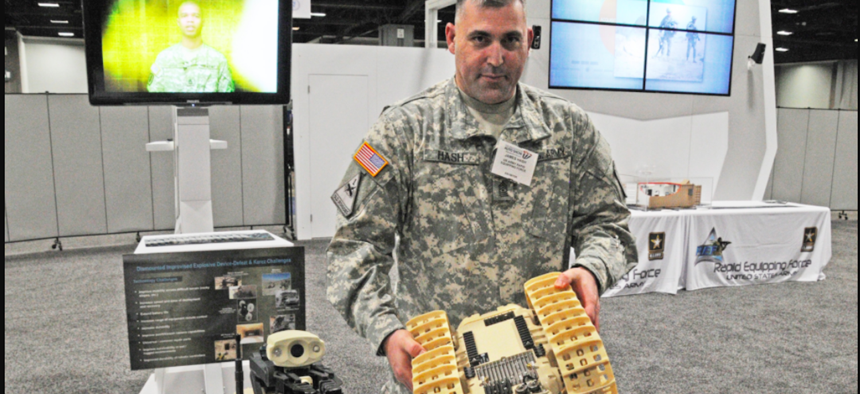
Sgt. Maj. James Hash shows a Rapid Equipping Force-procured Dragon Runner, operated by Soldiers remotely in Afghanistan for reconnaissance and counter improvised explosive device operations. The venue is the Washington Auto Show, in February 2013. U.S. Army
US Army To Dissolve Rapid Equipping Force, Asymmetric Warfare Group
It’s part of the service’s shift from counterinsurgency to near-peer fights, but some observers are concerned.
The U.S. Army on Friday announced that it will shutter the Asymmetric Warfare Group and the Rapid Equipping Force, two organizations created to speed information and gear to troops fighting insurgents and adversaries in Afghanistan and Iraq.
The service established the Asymmetric Warfare Group, or ASG, in 2006 out of Fort Meade in Maryland to “rapidly transfer current threat-based observations and solutions (TTPs) to tactical and operational Army commanders in order to defeat emerging asymmetric threats,” according to the group’s website. An operational unit of Training and Doctrine Command, AWG was seen as a means to quickly get intelligence about rapidly-changing insurgent tactics and weapons to soldiers downrange, at the “operational point of need.”
The Army stood up the Rapid Equipping Force, or REF, in 2002 at Fort Belvoir as a sort of workaround to the obstacles and delays that were common in the buying and distribution of vital equipment related to counterterrorism and counter-insurgency. The organization sought to provide “rapid solutions to problems Soldiers in Afghanistan encountered while conducting their mission. Such solutions can be developed in-house by REF engineers, and fielded quickly to Soldiers using commercial off-the-shelf or government-created technology,” according to a 2014 Army story. The story described the REF as “something the service needs for the long-term.”
But amid the Pentagon’s shift from the counterinsurgency operations that consumed most of its efforts in the decades following the 9/11 attacks, the Army in 2017 established the Army Futures Command in Austin, Texas, to develop next-generation technology that can help in fights against near-peer competitors such as China and Russia.
But there are still soldiers in Iraq and Afghanistan, even their numbers are shrinking. That makes the Army’s announcement “concerning,” according to Andrew Hunter, a senior fellow in the International Security Program and director of the Defense-Industrial Initiatives Group at the Center for Strategic and International Studies.
“There is still a need in the Army for being able to rapidly respond to new and emerging threats,” Hunter told Defense One in a message. “In some ways now more than ever, given the stepped-up efforts by adversaries to attack U.S. forces through unconventional means. And the Army has been DoD's primary engine for executing rapid acquisition.
“I think the key here is what organizations are picking up the mission to do this and whether they are resourced for it. However, the tenor of the statement is not encouraging on this count since it suggests that resources from the REF and AWG are begin shifted to other purposes.”
Retired Army lieutenant general Mike Nagata, who was the director of strategy for the National Counterterrorism Center from 2016 to 2019 and commanded Special Operations Command Central before that, said “'Asymmetry in warfare' and the need for 'rapid fielding of new capabilities' are as important today as they have ever been, and I personally think even moreso given the rapidly increasing complexity of our National Security challenges. What will take the place of both the AWG and the REF? If they are being replaced by other organizations or efforts that will be better, faster, and more effective, so much the better. If not… then it begs the question, 'why?'"
The groups will be fully dissolved by Sept. 30, 2021, the Army said in a Friday press release. “All lessons learned will be maintained by the U.S. Army Combined Arms Center (CAC), via the Center for Army Lessons Learned (CALL), Centers of Excellence (COEs), and other TRADOC enterprise stakeholders,” it said.





